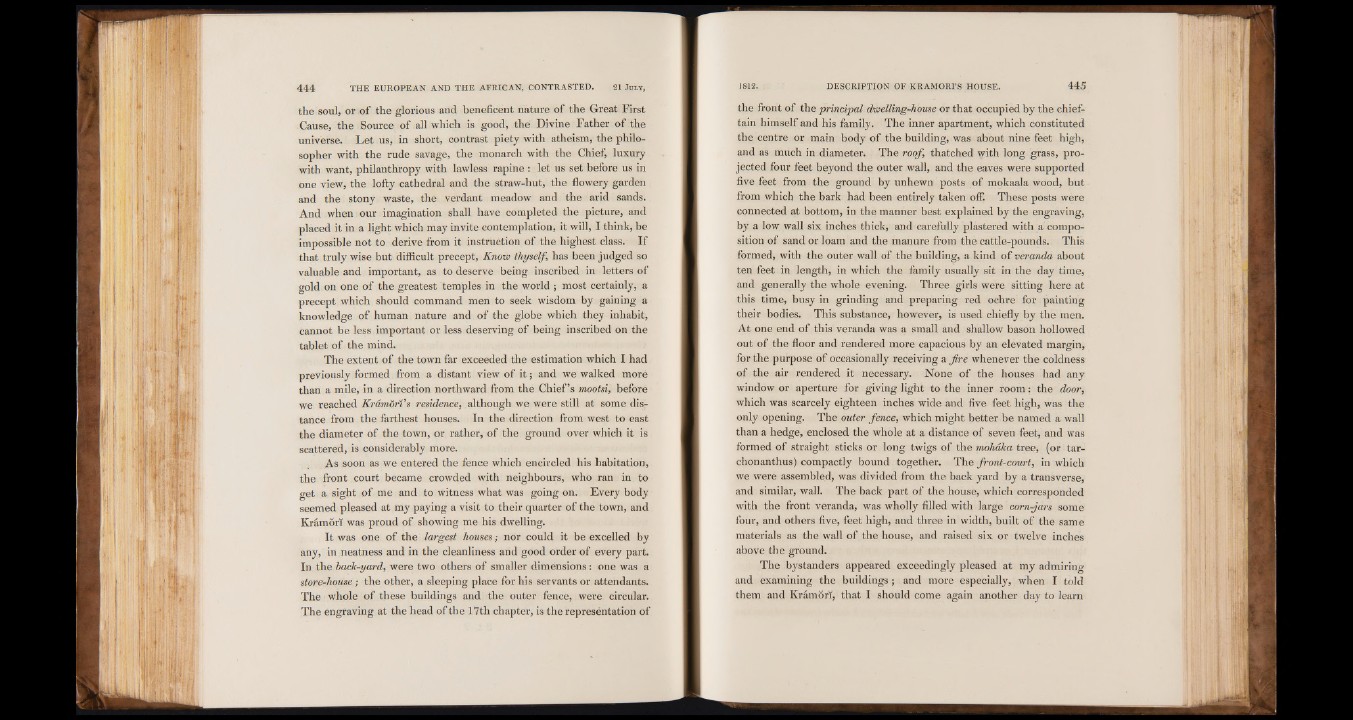
the soul, or of the glorious and beneficent nature of the Great First
Cause, the Source of all which is good, the Divine Father of the
universe. Let us, in short, contrast piety with atheism, the philosopher
with the rude savage, the monarch with the Chief, luxury
with want, philanthropy with lawless rapine : let us set before us in
one view, the lofty cathedral and the straw-hut, the flowery garden
and the stony waste, the verdant meadow and the arid sands.
And when our imagination shall have completed the picture, and
placed it in a light which may invite contemplation, it will, I think, be
impossible not to derive from it instruction of the highest class. If
that truly wise but difficult precept, Know thyself, has been judged so
valuable and important, as to deserve being inscribed in letters of
gold on one of the greatest temples in the world ; most certainly, a
precept which should command men to seek wisdom by gaining a
knowledge of human nature and of the globe which they inhabit,
cannot be less important or less deserving of being inscribed on the
tablet of the mind.
The extent of the town far exceeded the estimation which I had
previously formed from a distant view of it; and we walked more
than a mile, in a direction northward from the Chief’s mootsi, before
we reached Krâmôrt’s residence, although we were still at some disr
tance from the farthest houses. In the direction from west to east
the diameter of the town, or rather, of the ground over which it is
scattered, is considerably more.
As soon as we entered the fence which encircled his habitation,
the front court became crowded with neighbours, who ran in to
get a sight of me and to witness what was going on. Every body
seemed pleased at my paying a visit to their quarter of the town, and
Krâmôrï was proud of showing me his dwelling.
It was one of the largest houses ; nor could it be excelled by
any, in neatness and in the cleanliness and good order of every part.
In the back-yard, were two others of smaller dimensions : one was a
store-home ; the other, a sleeping place for his servants or attendants.
The whole of these buildings and the outer fence, were circular.
The engraving at the head of the 17th chapter, is the represéntation of
the front of the principal dwelling-house or that occupied by the chieftain
himself and his family. The inner apartment, which constituted
the centre or main body of the building, was about nine feet high,
and as much in diameter. The roof, thatched with long grass, projected
four feet beyond the outer wall, and the eaves were supported
five feet from the ground by unhewn posts of mokaala wood, but
from which the bark had been entirely taken off1. These posts were
connected at bottom, in the manner best explained by the engraving,
by a low wall six inches thick, and carefully plastered with a composition
of sand or loam and the manure from the cattle-pounds. This
formed, with the outer wall of the building, a kind of veranda about
ten feet in length, in which the family usually sit in the day time,
and generally the whole evening. Three girls were sitting here at
this time, busy in grinding and preparing red ochre for painting
their bodies. This substance, however, is used chiefly by the men.
At one end of this veranda was a small and shallow bason hollowed
out of the floor and rendered more capacious by an elevated margin,
lor the purpose of occasionally receiving a fire whenever the coldness
of the air rendered it necessary. None of the houses had any
window or aperture for giving light to the inner room: the door,
which was scarcely eighteen inches wide and five feet high, was the
only opening. The outer fence, which might better be named a wall
than a hedge, enclosed the whole at a distance of seven feet, and was
formed of straight sticks or long twigs of the mohdka tree, (or tar-
chonanthus) compactly bound together. The front-court, in which
we were assembled, was divided from the back yard by a transverse,
and similar, wall. The back part of the house, which corresponded
with the front veranda, was wholly filled with large corn-jars some
four, and others five, feet high, and three in width, built of the same
materials as the wall of the house, and raised six or twelve inches
above the ground.
The bystanders appeared exceedingly pleased at my admirin»
and examining the buildings ; and more especially, when I told
them and Kramorl, that I should come again another day to learn